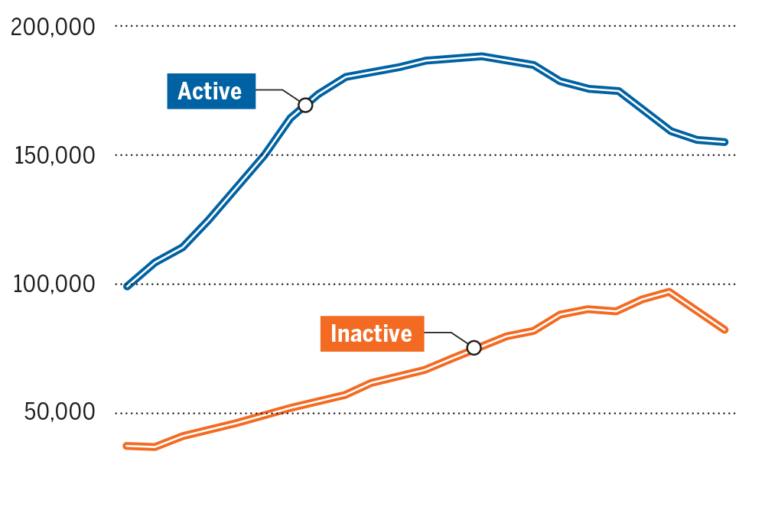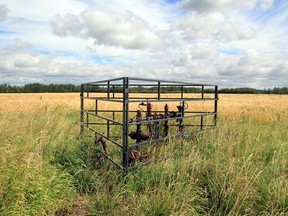
[ad_1]
Is the glass half-full, or half-empty, when it comes to Alberta’s latest attempts to tackle aging oil and gas wells across the province?
A new publication by the Alberta Energy Regulator (AER) provides some fuel for both sides of the long-running debate, by issuing its first “liability management industry performance report.”
It’s a mouthful, but what it’s assessing are steps by the conventional oil and gas sector to clean up thousands of wells and facilities in the province.
The study shows the industry spent $696 million for such activities, more than its combined mandatory quota of $422 million toward such closure work in 2022.
Mandatory spending levels for each well operator were first established by the AER for 2022 to ensure more wells were getting cleaned up, particularly as the backlog had increased in recent years.
The report stated 51 licence holders weren’t compliant and missed their closure spending levels by a combined $4.2 million, or one per cent of total sector spending requirements.
“The results of this report are a robust and clear indication that the industry is improving in the cleanup of oil and gas wells, pipelines and facilities,” AER CEO Laurie Pushor declared in a statement.
But it’s not quite so clear cut.
The sector did reduce the backlog of inactive wells by nine per cent (or more than 8,000 wells) to 83,000 throughout 2022, the period covered by this report.
The AER’s website indicates the number of inactive wells fell again last year by about 4,000.
“Progress is being made. You can generally see that reflected in the figures. The industry is spending substantially a larger amount than it has historically,” Tristan Goodman, head of the Explorers and Producers Association of Canada, said Wednesday.
For a province that saw the number of inactive wells increase annually by about five per cent between 2000 and 2020, that’s headway.
The reduction came after a period of high commodity prices, and as cash flow levels reached record levels. As well, the federal government announced in 2020 it would provide $1 billion for well decommissioning and site rehabilitation work in Alberta, with a chunk of activity taking place in 2022.
Total expenditures on closure activities — including well and facility decommissioning, remediation and reclamation work — reached $1.2 billion in 2022.
The total included $383 million from the federal commitment and $185 million spent by the Alberta Orphan Well Association (OWA), which is funded by an annual industry levy.
“The closure spend quotas are a good idea because it gives firms flexibility to optimize their decisions. It also sounds like it was a success,” University of Calgary economist Lucija Muehlenbachs, who has written about the issue of orphan wells, said in an email.
“That said, more telling of success will be what happens in future years, which won’t have the federal subsidy for cleanup.”
The report also says estimated liabilities, which include decommissioning and reclamation costs associated with wells and facilities, actually increased by 12 per cent in 2022 from the previous year’s levels, totalling $33.6 billion.
AER officials said methodology changes in 2022 led to the increase. (Those estimated liabilities dropped to $33.3 billion as of January 2023.)
-
 Alberta Energy Regulator applauds well cleanup efforts but $33B liability estimate too low, critic says
Alberta Energy Regulator applauds well cleanup efforts but $33B liability estimate too low, critic says -
 Alberta researchers call for public inquiry into program to ensure oilsands cleanup
Alberta researchers call for public inquiry into program to ensure oilsands cleanup -
 Alberta regulator mulls reducing liability of old wells before cleanup certified
Alberta regulator mulls reducing liability of old wells before cleanup certified -
 Varcoe: Industry gives mixed reviews to UCP incentives for well cleanup pilot
Varcoe: Industry gives mixed reviews to UCP incentives for well cleanup pilot -
 Alberta to overhaul ‘flawed’ scheme that regulates old oil and gas infrastructure
Alberta to overhaul ‘flawed’ scheme that regulates old oil and gas infrastructure
The study indicated about three-quarters of the total liability is held by healthy companies considered by the regulator to be in “low financial distress.”
There are 129 licensees considered by the regulator to be in “high financial distress,” with total liabilities of more than $2.4 billion.
As past downturns have shown, a sharp decrease in oil and gas prices means more work for the OWA, which is responsible for cleaning up wells if no owner exists to pay for the tab.
(There were 2,995 orphan sites recorded at the end of last year.)
Last year, a report for the University of Calgary School of Public Policy called Alberta’s policy on inactive and orphan wells “a massive regulatory failure.”
Report co-author Martin Olszynski, a law professor at the university, said the latest AER report is relying on liability estimates that it has known for years aren’t reliable. The $33-billion figure is “a gross underestimate” of the total, he said.
“Not only are we not keeping up with current liabilities . . . liabilities are going up because we are drilling more, but we don’t secure those liabilities in any kind of meaningful way,” Olszynski said.
“This isn’t actually about transparency and accountability. This is a sales job.”
AER officials say they will be moving in the future to a “much more accurate model” that will be based on more closure information.
“Once we have sufficient data points across the province for closure activities, we will replace the methodology that was used to calculate the $33-billion estimate,” said AER’s director of liability management David Hardie.
He also noted there is a time lag between when the cleanup work is done and when the liabilities can be removed from the books.
The mandatory spending quota for 2024 has been set at $700 million.

Neil McCrank, who was the chair of the AER’s predecessor (the Alberta Energy Resources Conservation Board) from 1998 until 2007, said concerns about orphan and inactive wells date back decades.
He recalls the regulator tackling the cleanup of the notorious Old Salty well, which had been drilled in 1916 and hit a pressurized aquifer, spewing salt water and gas into the Peace River for decades. After several failed attempts, it was eventually sealed in 2003.
McCrank said it’s important the regulator ensures environmental obligations are met and hopes the public continues to press the government and AER on the issue.
“If my review of this report is accurate, we’re taking a good stab at making sure that the last man standing is a company that has the wherewithal to deal with it,” he said.
“Public pressure means a lot on those things. And the last thing you want is the government to have to come in and clean up a mess.”
Chris Varcoe is a Calgary Herald columnist.
[ad_2]
You can read more of the news on source





